COMMENT OF THE DAY: THE KIND OF ZONING HOUSTON DOES HAVE  “. . . I always chuckle a bit when someone thinks that the free market governs Houston because the City doesn’t have zoning.
Aside from land-use restrictions, every regulation that is usually found in a zoning ordinance is in force in Houston. Tree and landscape requirements. Setbacks. Sign ordinance. Curb cut requirements. Buffering. Parking requirements. Traffic study requirements. Plan reviews for subdivisions. Regulations for building in flood plains and finish floor elevations. The list goes on. And like every other city, Houston enforces building, electrical, fire, residential, and plumbing codes (with amendments). So contrary to what a lot of a lot of people think, Houston is not a developer’s free for all. (Not that it wasn’t in the 1970s, but I digress)
If anything, it’s harder to build in Houston because the regulations are so damned hard to find sometimes. In most places, it’s all neatly packaged in a Zoning Ordinance. In Houston, it’s all over the Code of Ordinances, and you have to know where to look. As HouCynic noted, Houston enforces neighborhood deed restrictions, but the County Clerk actually records those Restrictions, so it’s not a one-stop-shop. . . .” [ZAW, commenting on Medistar’s Planned Webster Sprawl Plaza; The Most Congested Roads in Texas; Free Metro Rides] Illustration: Lulu
“. . . I always chuckle a bit when someone thinks that the free market governs Houston because the City doesn’t have zoning.
Aside from land-use restrictions, every regulation that is usually found in a zoning ordinance is in force in Houston. Tree and landscape requirements. Setbacks. Sign ordinance. Curb cut requirements. Buffering. Parking requirements. Traffic study requirements. Plan reviews for subdivisions. Regulations for building in flood plains and finish floor elevations. The list goes on. And like every other city, Houston enforces building, electrical, fire, residential, and plumbing codes (with amendments). So contrary to what a lot of a lot of people think, Houston is not a developer’s free for all. (Not that it wasn’t in the 1970s, but I digress)
If anything, it’s harder to build in Houston because the regulations are so damned hard to find sometimes. In most places, it’s all neatly packaged in a Zoning Ordinance. In Houston, it’s all over the Code of Ordinances, and you have to know where to look. As HouCynic noted, Houston enforces neighborhood deed restrictions, but the County Clerk actually records those Restrictions, so it’s not a one-stop-shop. . . .” [ZAW, commenting on Medistar’s Planned Webster Sprawl Plaza; The Most Congested Roads in Texas; Free Metro Rides] Illustration: Lulu
Quicklink
WESTBURY SQUARE HEADED FOR SALE, EXILE OF REMAINING TENANTS 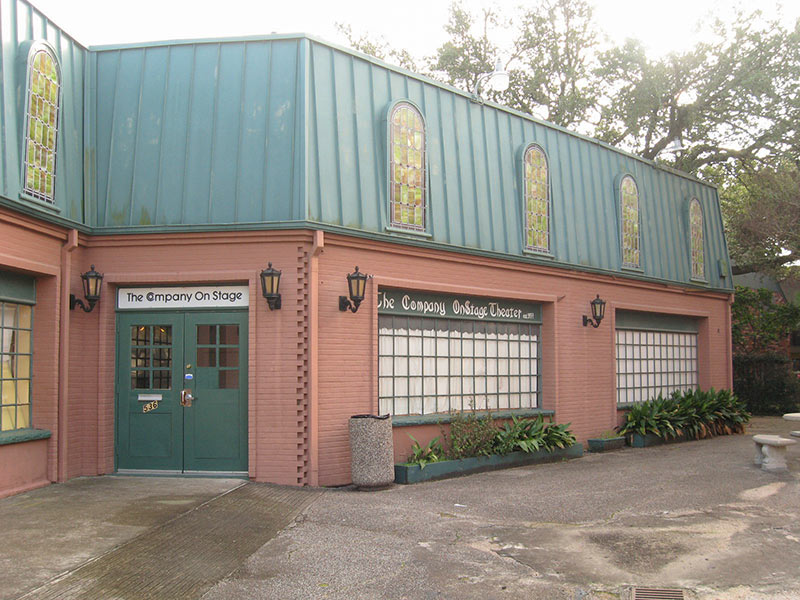 A sales contract is pending on the remaining portions of faded pedestrian shopping district Westbury Square, a note posted to the home page of The Company OnStage and sent to the group’s subscribers announces. The note does not address rumored plans to divide the purchased site near the intersection of West Bellfort and Chimney Rock into more than 100 townhome lots, but does indicate that completion of the sale will likely bring an end to the company’s 33-year residency at 536 Westbury Square (pictured here). The theater group is postponing the announcement of its upcoming season, and says it is looking to relocate. Two buildings in the complex were torn down early last year. [The Company OnStage; previously on Swamplot] Photo: The Company OnStage
A sales contract is pending on the remaining portions of faded pedestrian shopping district Westbury Square, a note posted to the home page of The Company OnStage and sent to the group’s subscribers announces. The note does not address rumored plans to divide the purchased site near the intersection of West Bellfort and Chimney Rock into more than 100 townhome lots, but does indicate that completion of the sale will likely bring an end to the company’s 33-year residency at 536 Westbury Square (pictured here). The theater group is postponing the announcement of its upcoming season, and says it is looking to relocate. Two buildings in the complex were torn down early last year. [The Company OnStage; previously on Swamplot] Photo: The Company OnStage
COMMENT OF THE DAY: THE REAL DIFFERENCE NOT HAVING ZONING MAKES 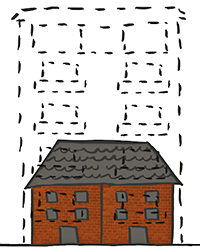 “For a city without zoning, development in Houston isn’t much different that it would be if we DID have zoning. Most retail development happens on major commercial thoroughfares, and most industrial sites are either along railway lines or otherwise clustered together. And development still has to comply with our (idiotic) setback requirements and parking minimums.
The main difference Houston has over other cities with stricter land use regulation, is the ability to increase residential density in a fairly timely manner. This has helped keep housing costs from rising higher than they otherwise would have. The kinds of land use regulation in cities like New York, Washington and San Francisco generally benefit wealthy landowners at the expense of younger, poorer new-comers. Even current middle-class homeowners don’t really benefit: you can’t bank the appreciation until you sell, at which point you still have to live somewhere, and in the meantime, your property tax bill is higher.” [Angostura, commenting on Medistar’s Planned Webster Sprawl Plaza; The Most Congested Roads in Texas; Free Metro Rides] Illustration: Lulu
“For a city without zoning, development in Houston isn’t much different that it would be if we DID have zoning. Most retail development happens on major commercial thoroughfares, and most industrial sites are either along railway lines or otherwise clustered together. And development still has to comply with our (idiotic) setback requirements and parking minimums.
The main difference Houston has over other cities with stricter land use regulation, is the ability to increase residential density in a fairly timely manner. This has helped keep housing costs from rising higher than they otherwise would have. The kinds of land use regulation in cities like New York, Washington and San Francisco generally benefit wealthy landowners at the expense of younger, poorer new-comers. Even current middle-class homeowners don’t really benefit: you can’t bank the appreciation until you sell, at which point you still have to live somewhere, and in the meantime, your property tax bill is higher.” [Angostura, commenting on Medistar’s Planned Webster Sprawl Plaza; The Most Congested Roads in Texas; Free Metro Rides] Illustration: Lulu
YOUR UPGRADE FROM SHEPHERD DR. TO THE NORTH FWY. WILL BE MUCH SMOOTHER STARTING TODAY 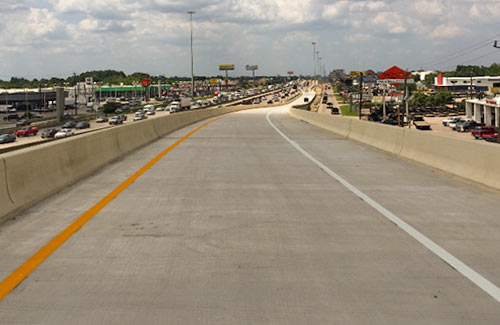 Today at noon TxDOT opened the brand new connector ramp pictured here, which has been under construction since December 2013. It links northbound traffic at the northern end of Shepherd Dr. to northbound I-45. Wasn’t there a way to get from Shepherd to I-45 already? Yes, but it brought cars into the freeway’s left lane. The new flyover crosses over the freeway to bring drivers onto I-45’s right lane; it hops over the Little York, Victory Blvd., and Veterans Memorial intersections on the way. A separate connector from I-45 south to Shepherd is scheduled to open later this summer. [TxDOT] Photo: TxDOT
Today at noon TxDOT opened the brand new connector ramp pictured here, which has been under construction since December 2013. It links northbound traffic at the northern end of Shepherd Dr. to northbound I-45. Wasn’t there a way to get from Shepherd to I-45 already? Yes, but it brought cars into the freeway’s left lane. The new flyover crosses over the freeway to bring drivers onto I-45’s right lane; it hops over the Little York, Victory Blvd., and Veterans Memorial intersections on the way. A separate connector from I-45 south to Shepherd is scheduled to open later this summer. [TxDOT] Photo: TxDOT
COMMENT OF THE DAY: NEW HOMES HAVE BEEN GROWING BIGGER FOR LESS  “The funny thing is that back in the 1930s, people actually needed more space than they do today. The average size of a household in the 30s was just over 4 people. It has shrunk to ~2.5 today (although some rich folk do breed like rabbits for some reason). In the olden days, people would have large libraries of books. Now, all that can be kept on an iPad or kindle. People used to have large record collections and “hifi†stereos that were their own pieces of furniture. Now, you can store all your music on your phone and plug it into a massive sound system that is completely built into the wall of each room. Same goes for a TV set. I remember my mom chewing me out for leaving my soda cans on top of the old RCA because it left a ring on the wood. Now, the TV hangs on the wall and is just a few inches thick. Rich folk today do like to have a closet full of clothes that look like a small version of a high end retail clothing store. But today, most people, even rich folks, dress casual all the time. Back in the 30s, 40s, 50s, etc., people would dress up to ride on a plane, men would wear suits all the time, and women would have a collection of hats in large hat boxes to fill up the closet. But houses just keep getting bigger and bigger and bigger as people have fewer reasons for living in such huge houses.” [Old School, commenting on Daily Demolition Report: Lakes Out] Illustration: Lulu
“The funny thing is that back in the 1930s, people actually needed more space than they do today. The average size of a household in the 30s was just over 4 people. It has shrunk to ~2.5 today (although some rich folk do breed like rabbits for some reason). In the olden days, people would have large libraries of books. Now, all that can be kept on an iPad or kindle. People used to have large record collections and “hifi†stereos that were their own pieces of furniture. Now, you can store all your music on your phone and plug it into a massive sound system that is completely built into the wall of each room. Same goes for a TV set. I remember my mom chewing me out for leaving my soda cans on top of the old RCA because it left a ring on the wood. Now, the TV hangs on the wall and is just a few inches thick. Rich folk today do like to have a closet full of clothes that look like a small version of a high end retail clothing store. But today, most people, even rich folks, dress casual all the time. Back in the 30s, 40s, 50s, etc., people would dress up to ride on a plane, men would wear suits all the time, and women would have a collection of hats in large hat boxes to fill up the closet. But houses just keep getting bigger and bigger and bigger as people have fewer reasons for living in such huge houses.” [Old School, commenting on Daily Demolition Report: Lakes Out] Illustration: Lulu
REVEALING THE FULL PLAN FOR SKANSKA’S DOWNTOWN BLOCK WILL TAKE SOME TIME 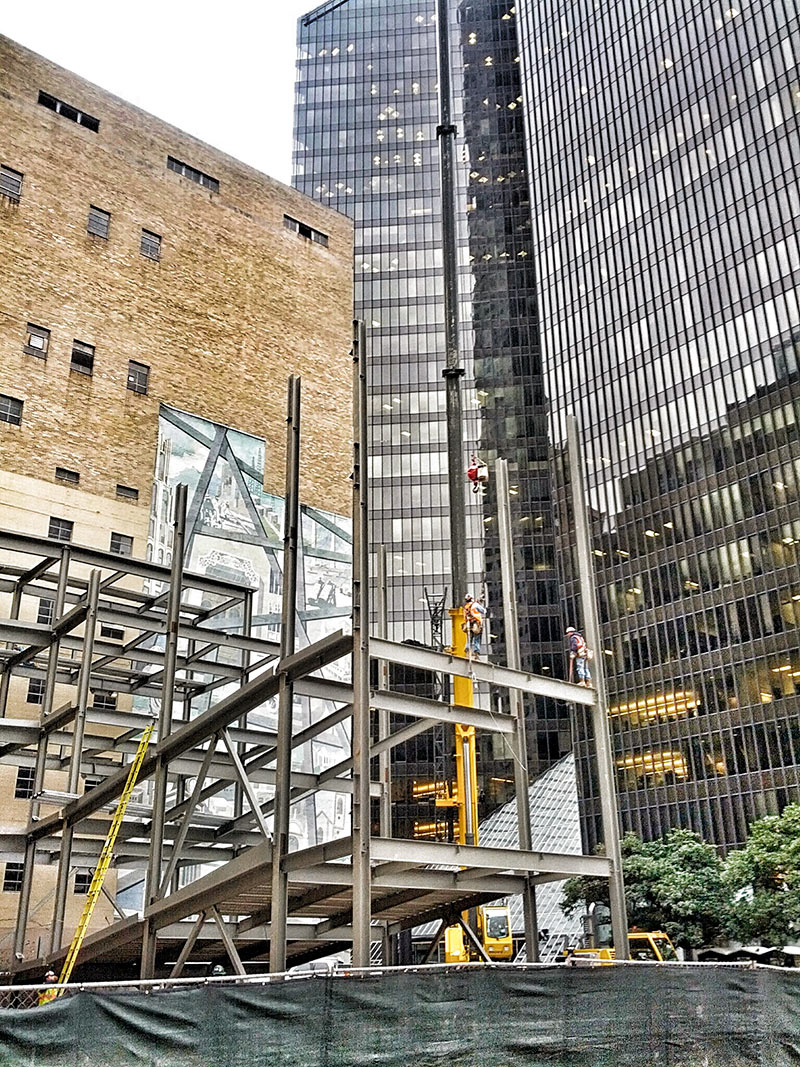 The Chronicle‘s Nancy Sarnoff does her level best to decipher and explain the strange sequence of events at Skanska’s ongoing demolition-construction-demolition-construction project across the street from Pennzoil Place: “The developer planning Capitol Tower, the 35-story office building slated for downtown’s former Houston Club building site, is planning to pour the foundation for the structure next month, but as of now, there are no plans to construct the tower portion of the project. So what’s with all the construction on the property? The Houston Club building was imploded last year, but the garage on the site was to remain because of an existing parking contract. During the implosion, however, the garage was damaged and had to be demolished. Project developer Skanska USA Commercial Development is now building a new garage on the southern half of the block. ‘We’re still executing our project plans,’ said Michael Mair, executive vice president and regional manager for Skanska USA in Houston.” Left out of the explanation: The multi-story steel parking structure and ramps Skanska built for the garage before it was demolished — pictured here under construction in front of the then-still-standing Houston Club Building last March. The downtown block, surrounded by Rusk, Travis, Milam, and Capitol streets, is now empty. [Prime Property; previously on Swamplot] Photo: Swamplot inbox
The Chronicle‘s Nancy Sarnoff does her level best to decipher and explain the strange sequence of events at Skanska’s ongoing demolition-construction-demolition-construction project across the street from Pennzoil Place: “The developer planning Capitol Tower, the 35-story office building slated for downtown’s former Houston Club building site, is planning to pour the foundation for the structure next month, but as of now, there are no plans to construct the tower portion of the project. So what’s with all the construction on the property? The Houston Club building was imploded last year, but the garage on the site was to remain because of an existing parking contract. During the implosion, however, the garage was damaged and had to be demolished. Project developer Skanska USA Commercial Development is now building a new garage on the southern half of the block. ‘We’re still executing our project plans,’ said Michael Mair, executive vice president and regional manager for Skanska USA in Houston.” Left out of the explanation: The multi-story steel parking structure and ramps Skanska built for the garage before it was demolished — pictured here under construction in front of the then-still-standing Houston Club Building last March. The downtown block, surrounded by Rusk, Travis, Milam, and Capitol streets, is now empty. [Prime Property; previously on Swamplot] Photo: Swamplot inbox
IT’S BEDTIME AT AN ANNA’S LINENS NEAR YOU 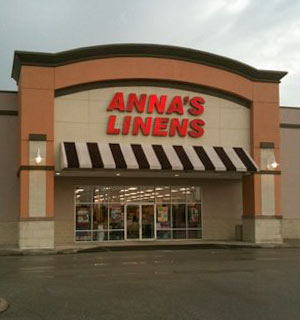 All 19 Houston-area Anna’s Linens stores — and the remaining 233 locations in the U.S. and Puerto Rico, for good measure — will be selling off their sheets, towels, and draperies and shutting down. The company had filed bankruptcy on June 14th, but hoped to sell the stores before a deadline last Friday. Instead, some going-out-of-business-sale conductors will be taking over operations, selling off all inventory and fixtures, and turning out the lights. [Home & Textiles Today, via Real Estate Bisnow] Photo of Anna’s Linens at 8232-A Kirby Dr., across from NRG Stadium and the Astrodome: Edgar V.
All 19 Houston-area Anna’s Linens stores — and the remaining 233 locations in the U.S. and Puerto Rico, for good measure — will be selling off their sheets, towels, and draperies and shutting down. The company had filed bankruptcy on June 14th, but hoped to sell the stores before a deadline last Friday. Instead, some going-out-of-business-sale conductors will be taking over operations, selling off all inventory and fixtures, and turning out the lights. [Home & Textiles Today, via Real Estate Bisnow] Photo of Anna’s Linens at 8232-A Kirby Dr., across from NRG Stadium and the Astrodome: Edgar V.
KROGER SAYS IT HAS ‘NO PLANS’ TO CLOSE SIGNATURE STORE ON OST 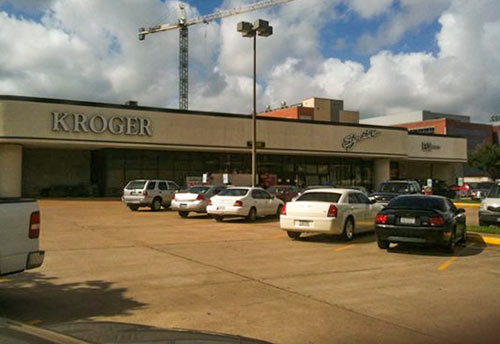 Responding to yesterday’s Swamplot story noting council member Dwight Boykins’s report to his constituents that Kroger is shutting down its store at the corner of Old Spanish Trail and Cambridge St., a spokesperson for the grocery store chain tells Swamplot that Kroger plans to “continue operating the store as a leased property to serve the medical center community,” and that “there are no plans at this time to close the location.” Kroger has been operating the grocery store at 1990 Old Spanish Trail since 1994. Photo: Edgar V.
Responding to yesterday’s Swamplot story noting council member Dwight Boykins’s report to his constituents that Kroger is shutting down its store at the corner of Old Spanish Trail and Cambridge St., a spokesperson for the grocery store chain tells Swamplot that Kroger plans to “continue operating the store as a leased property to serve the medical center community,” and that “there are no plans at this time to close the location.” Kroger has been operating the grocery store at 1990 Old Spanish Trail since 1994. Photo: Edgar V.
THE KROGER ON OST AT CAMBRIDGE ST. IS CLOSING 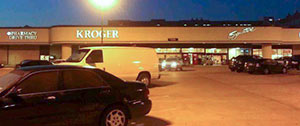 Citing the demographics and income levels of the surrounding neighborhood, officials from Kroger tell Dwight Boykins that the Signature Kroger at 1990 Old Spanish Trail, immediately north of UTHealth’s Research Park complex, is closing, the council member reports. The store is the closest supermarket to the Texas Medical Center main campus. Boykins cited the decision in explaining why he delayed a vote on Kroger’s request for a $775K tax abatement connected to the expansion of the company’s distribution center at 701 Gellhorn Dr., near the intersection of the East Fwy. and the East Loop. Kroger was granted the abatement by a vote of city council yesterday, with Boykins absent. Update, 6/19: Kroger responds. [Houston Style Magazine, via HAIF; Houston Chronicle] Photo: Juleena M.
Citing the demographics and income levels of the surrounding neighborhood, officials from Kroger tell Dwight Boykins that the Signature Kroger at 1990 Old Spanish Trail, immediately north of UTHealth’s Research Park complex, is closing, the council member reports. The store is the closest supermarket to the Texas Medical Center main campus. Boykins cited the decision in explaining why he delayed a vote on Kroger’s request for a $775K tax abatement connected to the expansion of the company’s distribution center at 701 Gellhorn Dr., near the intersection of the East Fwy. and the East Loop. Kroger was granted the abatement by a vote of city council yesterday, with Boykins absent. Update, 6/19: Kroger responds. [Houston Style Magazine, via HAIF; Houston Chronicle] Photo: Juleena M.
SHAKING AT THE TOP OF A HOUSTON SKYSCRAPER IN THE MIDDLE OF A HURRICANE  Houstonians who were around for Hurricane Alicia in 1983 might remember that the Wells Fargo Plaza tower downtown — then known as the brand-new Allied Bank Plaza — ended up losing more than 3,000 glass panels in the storm. But did you know that the building that night became the site of one of the few live wiggling-skyscrapers-in-a-storm experiments ever conducted? Engineers Robert Halvorson and Michael Fletcher spent the night of the hurricane in the 71-story tower’s unfinished top floor, just to see how much the building would sway; more than 30 years later, they described their experiences to Washington Post reporter Emily Badger. The peak acceleration of 43 milli-g’s they recorded — enough back-and-forth and twisting to make it impossible for them to walk upright — turned out to be “give or take, exactly the same thing that had been predicted by the wind tunnel” before the structure was built. [Gizmodo] Photo of Wells Fargo Plaza: Jackson Myers
Houstonians who were around for Hurricane Alicia in 1983 might remember that the Wells Fargo Plaza tower downtown — then known as the brand-new Allied Bank Plaza — ended up losing more than 3,000 glass panels in the storm. But did you know that the building that night became the site of one of the few live wiggling-skyscrapers-in-a-storm experiments ever conducted? Engineers Robert Halvorson and Michael Fletcher spent the night of the hurricane in the 71-story tower’s unfinished top floor, just to see how much the building would sway; more than 30 years later, they described their experiences to Washington Post reporter Emily Badger. The peak acceleration of 43 milli-g’s they recorded — enough back-and-forth and twisting to make it impossible for them to walk upright — turned out to be “give or take, exactly the same thing that had been predicted by the wind tunnel” before the structure was built. [Gizmodo] Photo of Wells Fargo Plaza: Jackson Myers
$150 HOUSE HEADED FOR THE MLS, EXPECTING MUCH HIGHER OFFERS 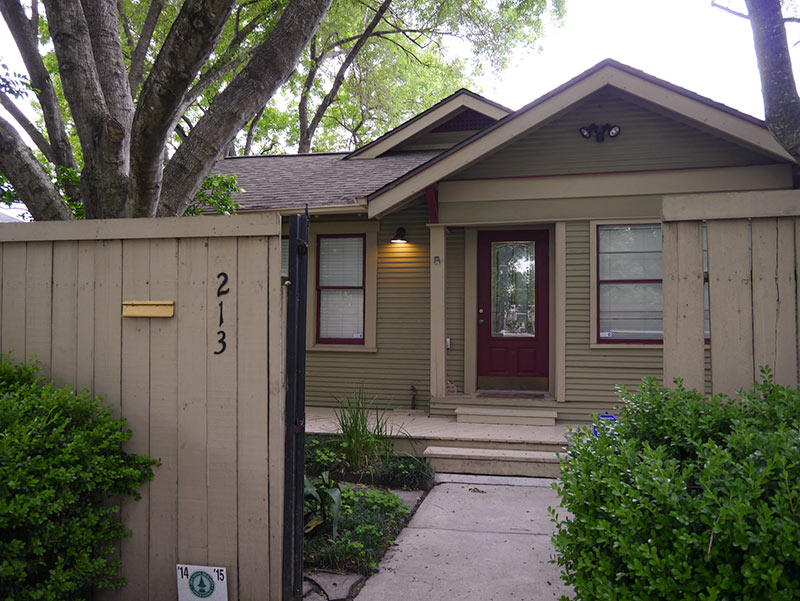 Here’s the final tally for real estate agent Michael Wachs’s failed attempt to sell his Heights bungalow at 213 E. 23rd. St. for $150: After a flurry of late entries, the total number of essays-with-$150-application-fees came to more than 1000, though a slightly larger number of essays came in without any fees at all. Wachs and his family are now rich in heartfelt stories documenting the residential yearnings of strangers, but the total funds received were not enough to “make it work,” Wachs writes in a new note on the house-offer website. He’ll soon be listing the house on HAR at a much higher price, and accepting what he terms “traditional” offers, though he does encourage interested buyers to attach a “heartstrings” letter. A FAQ about fee refunds has been posted to the website as well. [$150 House; previously on Swamplot] Photo: $150 House.
Here’s the final tally for real estate agent Michael Wachs’s failed attempt to sell his Heights bungalow at 213 E. 23rd. St. for $150: After a flurry of late entries, the total number of essays-with-$150-application-fees came to more than 1000, though a slightly larger number of essays came in without any fees at all. Wachs and his family are now rich in heartfelt stories documenting the residential yearnings of strangers, but the total funds received were not enough to “make it work,” Wachs writes in a new note on the house-offer website. He’ll soon be listing the house on HAR at a much higher price, and accepting what he terms “traditional” offers, though he does encourage interested buyers to attach a “heartstrings” letter. A FAQ about fee refunds has been posted to the website as well. [$150 House; previously on Swamplot] Photo: $150 House.
BLACK LAB EDGES OUT MELANGE CREPERIE FOR EATSIE BOYS SPACE 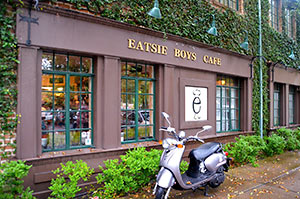 The old “circumstances beyond our control” got in the way of Melange Creperie’s previously announced move into the former Eatsie Boys spot in the Campanile center at 4100 Montrose Blvd., the crepe stand’s proprietor announced late last week. Eric Sandler reports that the location’s neighbor, The Black Labrador pub, will instead expand into the space. In an email sent to backers of the Kickstarter through which $52,215 was raised for the crepe stand’s move to an indoor site, owner Sean Carroll reported he’s still looking in Midtown and Montrose for a lease space. In the meantime, Melange Creperie will begin operating regular hours next to the freezer case inside the Montrose H-E-B. [Culturemap; Houston Chronicle; previously on Swamplot] Photo of 4100 Montrose Blvd.: Local Sugar
The old “circumstances beyond our control” got in the way of Melange Creperie’s previously announced move into the former Eatsie Boys spot in the Campanile center at 4100 Montrose Blvd., the crepe stand’s proprietor announced late last week. Eric Sandler reports that the location’s neighbor, The Black Labrador pub, will instead expand into the space. In an email sent to backers of the Kickstarter through which $52,215 was raised for the crepe stand’s move to an indoor site, owner Sean Carroll reported he’s still looking in Midtown and Montrose for a lease space. In the meantime, Melange Creperie will begin operating regular hours next to the freezer case inside the Montrose H-E-B. [Culturemap; Houston Chronicle; previously on Swamplot] Photo of 4100 Montrose Blvd.: Local Sugar
COMMENT OF THE DAY: LET’S KEEP HOUSTON’S ODDBALL ORIGINALITY A LITTLE MORE ORIGINAL AND LOCAL, PLEASE  “Well, so much for the oddball originality that made Houston special. If you’re gonna rip off an idea, at least cover your house in wine corks or build an elaborate complex paying homage to the health benefits of bananas. Come on, people, you’re better than this.” [Amanda, commenting on Houstonians Are Attaching Their ‘Love Locks’ to Buffalo Bayou’s Rosemont Bridge] Illustration: Lulu
“Well, so much for the oddball originality that made Houston special. If you’re gonna rip off an idea, at least cover your house in wine corks or build an elaborate complex paying homage to the health benefits of bananas. Come on, people, you’re better than this.” [Amanda, commenting on Houstonians Are Attaching Their ‘Love Locks’ to Buffalo Bayou’s Rosemont Bridge] Illustration: Lulu
HOUSTON’S LAST TEXADELPHIA HAS SERVED ITS FINAL CHEESESTEAK 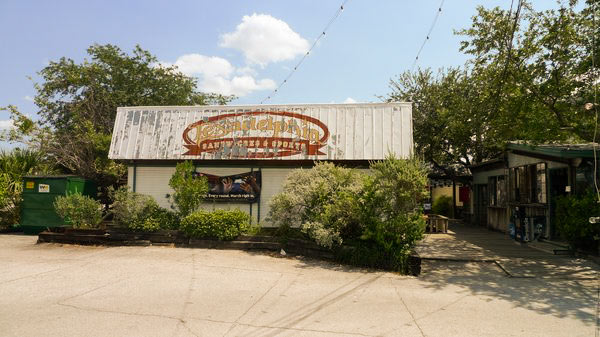 Texas cheesesteak sports bar Texadelphia has closed, a couple of readers tell Swamplot. The spot at 6025 Westheimer Rd., west of Fountainview, was the first and last of the Houston locations for the Austin-born franchise. This spot had been open for about 20 years. Photo: Jack S.
Texas cheesesteak sports bar Texadelphia has closed, a couple of readers tell Swamplot. The spot at 6025 Westheimer Rd., west of Fountainview, was the first and last of the Houston locations for the Austin-born franchise. This spot had been open for about 20 years. Photo: Jack S.
A BETTER FENCE FOR THE AXIS APARTMENTS SITE 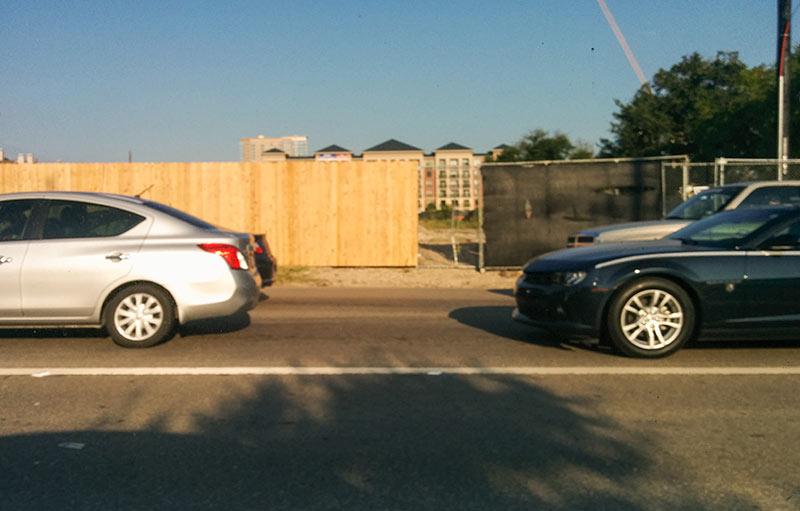 The construction fence surrounding the burned site of JLB Partners’ planned Axis Apartments at 2400 West Dallas St. in North Montrose is receiving an upgrade — from veiled chain link to wood plank. A reader who wonders if the property still qualifies as a construction site notes that the fence still blocks the sidewalk along W. Dallas. This photo shows the current intersection of the 2 fence types along Montrose Blvd. The apartments burned during construction last year. [Previously on Swamplot] Photo: Swamplot inbox
The construction fence surrounding the burned site of JLB Partners’ planned Axis Apartments at 2400 West Dallas St. in North Montrose is receiving an upgrade — from veiled chain link to wood plank. A reader who wonders if the property still qualifies as a construction site notes that the fence still blocks the sidewalk along W. Dallas. This photo shows the current intersection of the 2 fence types along Montrose Blvd. The apartments burned during construction last year. [Previously on Swamplot] Photo: Swamplot inbox

